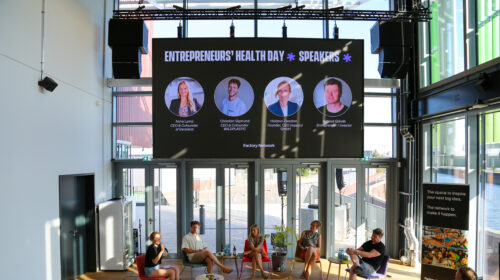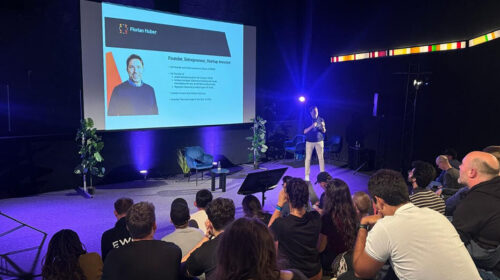
October 23, 2018
relayr: Revolutionising Industry with IoT
Last month, Munich Re acquired IoT startup relayr for US$ 300m via its subsidiary, Hartford Steam Boiler (HSB). relayr has developed a platform to connect hardware and software in order to monitor, maintain, and analyse machines and equipment. Their end-to-end solutions ensure lower likelihood of failure and damages, thus improving operational efficiency and profitability. This new partnership with Hartford Steam Boiler combines relayr’s vision and expertise in the Industrial Internet of Things (IoT) with financial and insurance components, to provide full service solutions to clients in technology, data analysis, financial instruments, and risk management.
The relayr Vision
relayr CTO Paul Hopton explains, for him, the relayr vision was inspired by the Bluebox which launched Cisco in 1984. The “Bluebox” functioned as a universal translator between the disparate networking protocols from the different PC makers (Apple, Microsoft, IBM, DECT, etc) all speaking different languages. They decided in 2013 there was a need for a similar platform for enabling communication between the emerging population of smart hardware (Nest Thermostats, Fitbits, Philips Hue Lightbulbs, Belkin light switches and smart plugs, Tesla cars, etc). Enabling them all to communicate together is what creates the real “Internet of Things”.
The notion of a platform and set of developer tools was inspired by Apple, which had created an app development platform where engineers build value-added services – the Apps – which create the actual user-value for the iPhone. Similarly, Facebook had created a social platform where developers could build value-added services to attract users and increase the stickiness of the platform. This is what relayr wanted to build – a tool. A platform where developers can connect any device of their choosing and build applications around those devices, and develop functionalities and value-added services, which we help monetise.
Back in 2013 and 2014, the “Internet of Things” was unbelievably difficult to explain. At the time, talk was around e-commerce and SaaS, but the concept of a platform-as-a-service – where you could build on other people’s software to make machines talk to each other – was a subject very few people truly understood.
relayr’s moment of validation came when they were picked up by Startupbootcamp in Amsterdam. The three founders were all asked to take a personality test, and from this they learned just how each one of them complemented the others. It was, in fact, less the business idea that attracted Startupbootcamp to relayr, but more the mature team. They admittedly did not perfectly understand what relayr was trying to build, but they saw value in the founders, their different backgrounds, and their different skill-sets.
Udo Schloemer has a similar philosophy. As he put it:
“"The greatest successes can come from random action, because it comes from the unplanned and unpredictable - when people from different cultures, different backgrounds, and different expertise come together and have the courage to execute an idea together."”
It was 2014 when Michael Bommer and Harald Zapp came to Udo with such an idea and the drive to realise it, but without the resources to make the jump. Upon realising the potential of sensors, Udo was excited about the technology. “Whether it’s a program that informs one’s grandson that the pillbox won’t open, or a window that changes colour to let neighbours know there’s been a break-in. The fact that you have information in the cloud and software defining how your hardware behaves, I found that totally fascinating at the time.” The IoT market was just taking off, and he could not stand by and just watch. Within two days, Udo became the first to invest in relayr.
Around this time, Factory Berlin was also taking shape and starting to grow rapidly into what it is today. It only made sense that Udo invite Harald to set up the relayr offices in a place where startups are encouraged and empowered to share their ideas and expertise to help each other grow. With a team of 20 and the promise of a valuable network, relayr moved in at Factory Berlin.
For relayr, the ultimate goal was to build a scalable platform in the cloud where people could program, develop, and build an entire network of systems. The missing piece of the puzzle was figuring out how to how to attract and onboard developers to the platform to start connecting things and building solutions.
Jackson Explains, “We discovered that what was missing was a set of easy-to-use sensors, hardware, basically what you can find in a mobile phone. App developers understand how to program applications for the smartphone, using its sensor data. If we could offer these sensors outside of the phone, you don’t need to understand the hardware anymore to understand how the sensor can be programmed. And from that seed of an idea we said, ‘ok, that could be something’. Then we started working on the idea of having different external programmable sensors that could be developed alone and connected automatically to our system.”
This evolved into relayr’s Go-To-Market Strategy – The Wunderbar. Wunderbar was a starter kit in the shape of a chocolate bar. It was a hardware kit of sensors, software APIs, and a cloud infrastructure, which empowered software engineers to design applications for the Internet of Things. They successfully crowdfunded it attracting 2,500 orders and engineers to connect to the relayr platform.
Community & Innovation at Factory Berlin
During their time at Factory Berlin, relayr was one of the very few companies who were not focused on the e-commerce and B2C markets. They were producing hardware, and providing a product that was complicated to explain – something totally innovative and above all, brave. The Factory community served as a support system. Jackson spent a lot of his time at Factory Berlin on stage giving talks to investors, corporates, and media, or around the building interacting with the other teams, startups and members. “We first recognised this network effect,” he recalls, “because we had hundreds of mentors who supported us, who were around every day, who we could pitch to and get qualified feedback.” The community at Factory Berlin provided a constant stream of feedback that acted as an accelerator to help propel relayr in the right direction. “Berlin is unique, and Factory is unique, in the sense that many different cultures, skillsets and very smart entrepreneurs, come together, enriching the mixture of ideas, and in turn enriching the company.”
Udo describes his vision for Factory Berlin, “I wanted rough. I wanted cool. I wanted people to feel comfortable, but still driven – feeling like they’re not finished. Feeling like it’s not perfect yet, that we still need to think ahead. That was my idea for Factory. I want to bring a lot of cool people together in one place, because I believe from that something new will emerge.” He describes the Factory dream as strengthening the German and European economy through provocation and disruption.
Berlin is the German center for disruption because it’s not perfect and people are not as “comfortable” as in Stuttgart or in Munich – Berliners are hungry, they are constantly seeking out improvement, change, innovation.
“"Berlin is a place that isn't all talk. People say they want to be cool, innovative, and disruptive - and in Berlin we found people who manifest this and understand how to make it happen. I think that also has to do with the long German tradition of research and development that goes into building a big company."”
Combining the Old and New Economy
Many companies from the old economy are believed to have a fear of disruption. As Udo puts it, they could have hundreds of people on payroll trying to develop better engines, better wheels, but no one is questioning – what about building something better than a car?
Something relayr struggled with was explaining to people why IoT was more than just hardware, and more than just software. As the concept started to grow in popularity, they realised if there are a lot of people talking long enough and loud enough about it, people start catching on, but to pitch the concept as a potential solution to real, relevant problems was not easy.
So they started to think of specific use cases and examples. Then they started building around these use cases to build up a portfolio of proof of success. Eventually, relayr had a network of thousands of developers – a network of crowdsourced talent and ideas – and it became clear to customers what the potential and possibilities of IoT really are.
When founding seed-investor and current CEO Josef Brunner came on board, he said “this product we have on tools.. It’s great, there is traction, but you can’t sell it, it is not bringing much revenue.” Josef had sold his previous company a cloud based platform for energy management – JouleX – to Cisco, so it was relatively easy for him to understand the relayr business model and the potential they have, but haven’t yet realised: to sell B2B solutions to corporates.
Being open to new ideas, taking advantage of coincidences and random occurrences, and having the flexibility to change things from one day to the next is something only disruptors can accomplish. Event amidst conflicting ideas, a strong core vision can guide decision-making and lead to success. Thus from a developer platform, relayr transformed into a solutions provider for corporates.
relayr x HSB: The Industrial IoT Powerhouse
With a growing number of IoT competitors in the market, relayr saw the opportunity for a merger as the perfect window of opportunity. As Jackson explains, “If we continue on our own, there’s a risk of constant distraction due to raising funding, round after round. Distraction slows growth..”
The German Mittelstand (SMEs) are not at the forefront of innovation, and the visionary startups do not have the resources and experience to scale properly and quickly without a proper partner. A startup with good proof of concept and a corporate partner with a similar vision and synergies can make the perfect merger. Such a partnership is established by long-term, sustainable thinking.
That’s what happened between relayr and MunichRe/Hartford Steam Boiler. HSB has a large network of industrial companies who stand to benefit greatly from risk-free digital transformation. To put it simply, they had the resources and the customers to strengthen relayr; relayr had the expertise, tools, and solutions to transform industry. An acquisition would stabilise growth and create synergies to reinforce the companies’ success.
If there is one learning to take out of this deal, it’s that Germany, and even conservative German companies, are beginning to understand the true potential of industry in the country. Udo believes “relayr is the catalyst for industry to understand that working together with startups is the key to starting a revolution.”

